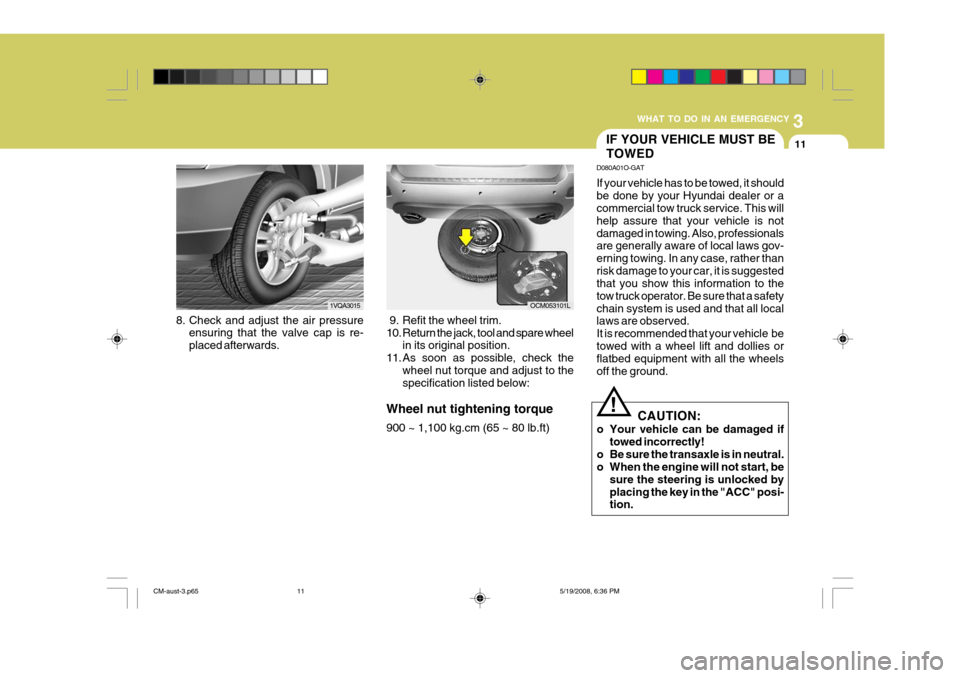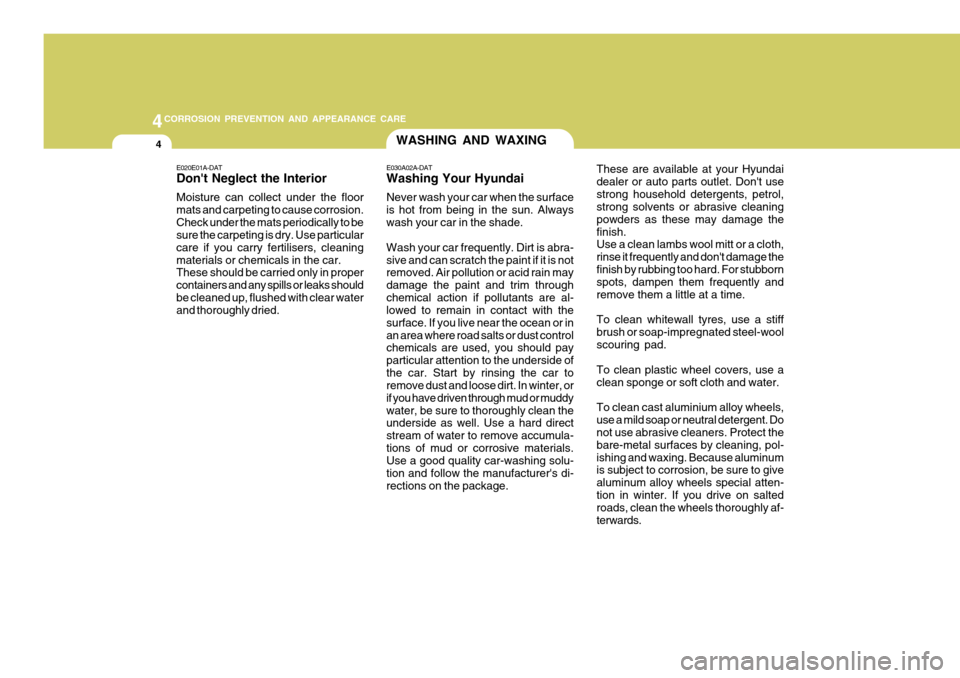Page 183 of 269

3WHAT TO DO IN AN EMERGENCY
8
!
1VQA4023
o The wheel diagonally opposite from the one to be changed should be blocked. 1. Remove the spare tyre and remove
the jack and tool from luggage com-partment.
NOTE: The spare tyre is located underneath the car.
WARNING:
Your vehicle is equipped with tyresdesigned to provide for safe ride andhandling capability. Do not use a size and type of tyre and wheel that is different from the onethat was originally installed on your vehicle. It can affect the safety and performance of your vehicle, whichcould lead to handling failure or rollover and serious injury. When replacing the tyres, be sure toequip all four tyres with the tyre and wheel of the same size, type, tread, brand and load-carrying capacity. Ifyou nevertheless decide to equip your vehicle with any tyre/wheel com- bination not recommended byHyundai for off-road driving, you should not use these tyres for high- way driving. o Allow the vehicle speed to decrease,
without using the brakes if possible.
o Pull off the road or into the curb where it is safe to do so and stop thevehicle. Turn off the engine.
o Activate the hazard warning lamp, apply the parking brake and placethe transaxle in gear ("P" position forAutomatic Transaxle).
o Passengers should not remain in-
side the vehicle during wheel chang-ing.
OCM054008
Flat tyre
CM-aust-3.p65 5/19/2008, 6:35 PM
8
Page 184 of 269
3
WHAT TO DO IN AN EMERGENCY
9
OCM054012
3. Engage the jack in the position shown and connecting the wrench bar with the wheel brace, raising the car untilthe wheel is clear of the ground.
Wrench bar
Wheel brace
2. Using the wheel brace, slacken each
roadwheel nut by no more than one half turn.
OCM054011OCM054013 NOTE: The jack should not be used on anything other than a firm flat base to prevent sinking or slippage.
CM-aust-3.p65
5/19/2008, 6:36 PM
9
Page 185 of 269
3WHAT TO DO IN AN EMERGENCY
10
!
5. Prior to replacing the road wheel,
ensure that the mating surfaces of the wheel and the hub are clean. OCM053104L
7. Lower the vehicle to the ground byusing wheel brace and tighten the nuts fully by using the wheel brace.
6. Replace the road wheel. Fit the wheel
nuts, with the tapered end towardsthe wheel and tighten.
D060I01O
WARNING:
Never work underneath the vehicle when it is supported by a jack. The jack is intended for use when wheelchanging only and no other pur- pose. When undertaking other main- tenance operations, a suitable jackand body supports must be used before any work commences. Seri- ous personal injury may result if thiswarning is ignored.
OCM053105L
OCM054014
OCM053103L
4. Remove the nuts and the road wheel.
CM-aust-3.p65 5/19/2008, 6:36 PM
10
Page 186 of 269

3
WHAT TO DO IN AN EMERGENCY
11
8. Check and adjust the air pressure
ensuring that the valve cap is re- placed afterwards. 1VQA3015
IF YOUR VEHICLE MUST BE TOWED
D080A01O-GAT If your vehicle has to be towed, it should be done by your Hyundai dealer or a commercial tow truck service. This will help assure that your vehicle is notdamaged in towing. Also, professionals are generally aware of local laws gov- erning towing. In any case, rather thanrisk damage to your car, it is suggested that you show this information to the tow truck operator. Be sure that a safetychain system is used and that all local laws are observed. It is recommended that your vehicle betowed with a wheel lift and dollies or flatbed equipment with all the wheels off the ground.
! CAUTION:
o Your vehicle can be damaged if towed incorrectly!
o Be sure the transaxle is in neutral.
o When the engine will not start, be
sure the steering is unlocked by placing the key in the "ACC" posi- tion.
9. Refit the wheel trim.
10. Return the jack, tool and spare wheel
in its original position.
11. As soon as possible, check the wheel nut torque and adjust to the specification listed below:
Wheel nut tightening torque 900 ~ 1,100 kg.cm (65 ~ 80 lb.ft)
OCM053101L
CM-aust-3.p65 5/19/2008, 6:36 PM
11
Page 187 of 269
3WHAT TO DO IN AN EMERGENCY
12
OCM054017
D080C01O-GAT Towing the 4 Wheel Drive Ve- hicle
OCM054033
When towing the 4WD vehicle, it must be towed by lifting all 4 wheels or usingthe towing dolly.
dolly
dolly CAUTION:
o The 4WD vehicle should never be towed with the wheels on the ground. This can cause serious damage to the transaxle or the 4WD system.
o When towing the vehicle, take care not to cause damage to the bumperor underbody of the vehicle.
!
OCM054034
o Do not tow with sling type truck as this may cause damage to the bumper or underbody of the ve- hicle. D080D01CM-DAT EMERGENCY TOWING
For emergency towing e.g. pulling the vehicle out of a ditch, mud or snow bank, attach a tow cable, chain or strap Towing Hook
OCM054016
Towing Hook
CM-aust-3.p65 5/19/2008, 6:36 PM
12
Page 188 of 269

3
WHAT TO DO IN AN EMERGENCY
13
to one of the towing hooks under the front/rear of your car. Do not attempt totow your vehicle in this manner on any unpaved surface. This could result in serious damage toyour car. Towing should not be at- tempted if the wheels, drive train, ax- les, steering or brakes are damaged.Before towing, be sure the transaxle is in neutral and the key is in "ACC" (with the engine off) or in the "ON" position(with the engine running). A driver must be in the towed car to steer it and operate the brakes. (1)To open the towing cover, push it with your finger.
(2)To mount the towing hook, rotate it
clockwise. (3)Attach a tow cable, chain or strap to
the towing hook on the rear bumper.
NOTE:
o To avoid serious damage to your 4WD vehicle, limit the towing to 15 km/h (10 mph) and not for morethan 1.5 km (1 mile) at ANY TIME.
o Before towing, check the level of
the automatic transaxle fluid. If itis below the 75°C range on the dipstick, add fluid. If you cannot add fluid, a towing dolly must beused.
!
! CAUTION
It should be tightened firmly with your fingers until there is no more play in the towing hole. Towing hook is located in the luggage compart-ment. CAUTION:
If the car is being towed with all four wheels on the ground, it can be towed only from the front. Be surethat the transaxle is in neutral. If your vehicle is equipped with the auto- matic transaxle, do not tow at speedsgreater than 50 km/h (30 mph) and for more than 25 km (15 miles). Be sure the steering is unlocked byplacing the key in the "ACC" posi- tion. A driver must be in the towed vehicle to operate the steering andbrakes.
! CAUTION:
The vehicle brakes have no power assistance when the engine is not running and the brake pedal willrequire very high pressure to stop the vehicle.
CM-aust-3.p65 5/19/2008, 6:36 PM
13
Page 193 of 269

4CORROSION PREVENTION AND APPEARANCE CARE
4WASHING AND WAXING
E020E01A-DAT Don't Neglect the Interior Moisture can collect under the floor mats and carpeting to cause corrosion.Check under the mats periodically to be sure the carpeting is dry. Use particular care if you carry fertilisers, cleaningmaterials or chemicals in the car. These should be carried only in proper containers and any spills or leaks shouldbe cleaned up, flushed with clear water and thoroughly dried. E030A02A-DAT Washing Your Hyundai Never wash your car when the surface is hot from being in the sun. Alwayswash your car in the shade. Wash your car frequently. Dirt is abra- sive and can scratch the paint if it is not removed. Air pollution or acid rain may damage the paint and trim throughchemical action if pollutants are al- lowed to remain in contact with the surface. If you live near the ocean or inan area where road salts or dust control chemicals are used, you should pay particular attention to the underside ofthe car. Start by rinsing the car to remove dust and loose dirt. In winter, or if you have driven through mud or muddywater, be sure to thoroughly clean the underside as well. Use a hard direct stream of water to remove accumula-tions of mud or corrosive materials. Use a good quality car-washing solu- tion and follow the manufacturer's di-rections on the package. These are available at your Hyundaidealer or auto parts outlet. Don't usestrong household detergents, petrol, strong solvents or abrasive cleaning powders as these may damage thefinish. Use a clean lambs wool mitt or a cloth, rinse it frequently and don't damage thefinish by rubbing too hard. For stubborn spots, dampen them frequently and remove them a little at a time. To clean whitewall tyres, use a stiff brush or soap-impregnated steel-woolscouring pad. To clean plastic wheel covers, use a clean sponge or soft cloth and water. To clean cast aluminium alloy wheels, use a mild soap or neutral detergent. Do not use abrasive cleaners. Protect the bare-metal surfaces by cleaning, pol-ishing and waxing. Because aluminum is subject to corrosion, be sure to give aluminum alloy wheels special atten-tion in winter. If you drive on salted roads, clean the wheels thoroughly af- terwards.
Page 207 of 269

5
VEHICLE MAINTENANCE REQUIREMENTS
11
F070M01A-AAT
o Steering Gear Box, Linkage &
Boots/Lower Arm Ball Joint
With the vehicle stopped and engine off, check for excessive free-play in the steering wheel. Check the linkage for bends or damage. Check the dustboots and ball joints for deterioration, cracks, or damage. Replace any dam- aged parts. F070N01A-AAT
o Power Steering Pump,
Belt and Hoses
Check the power steering pump and hoses for leakage and damage. Re-place any damaged or leaking parts immediately. Inspect the power steer- ing belt for evidence of cuts, cracks,excessive wear, oiliness and proper tension. Replace or adjust it if neces- sary. F070P01A-AAT
o Drive Shafts and Boots
Check the drive shafts, boots and
clamps for cracks, deterioration, or damage. Replace any damaged parts and, if necessary, repack the grease.
F070Q01A-AAT
o Air Conditioning Refrigerant
Check the air conditioning lines and
connections for leakage and damage.Check air conditioning performance according to the relevant shop manual if necessary.
CM-aust-5.p65 5/19/2008, 6:37 PM
11